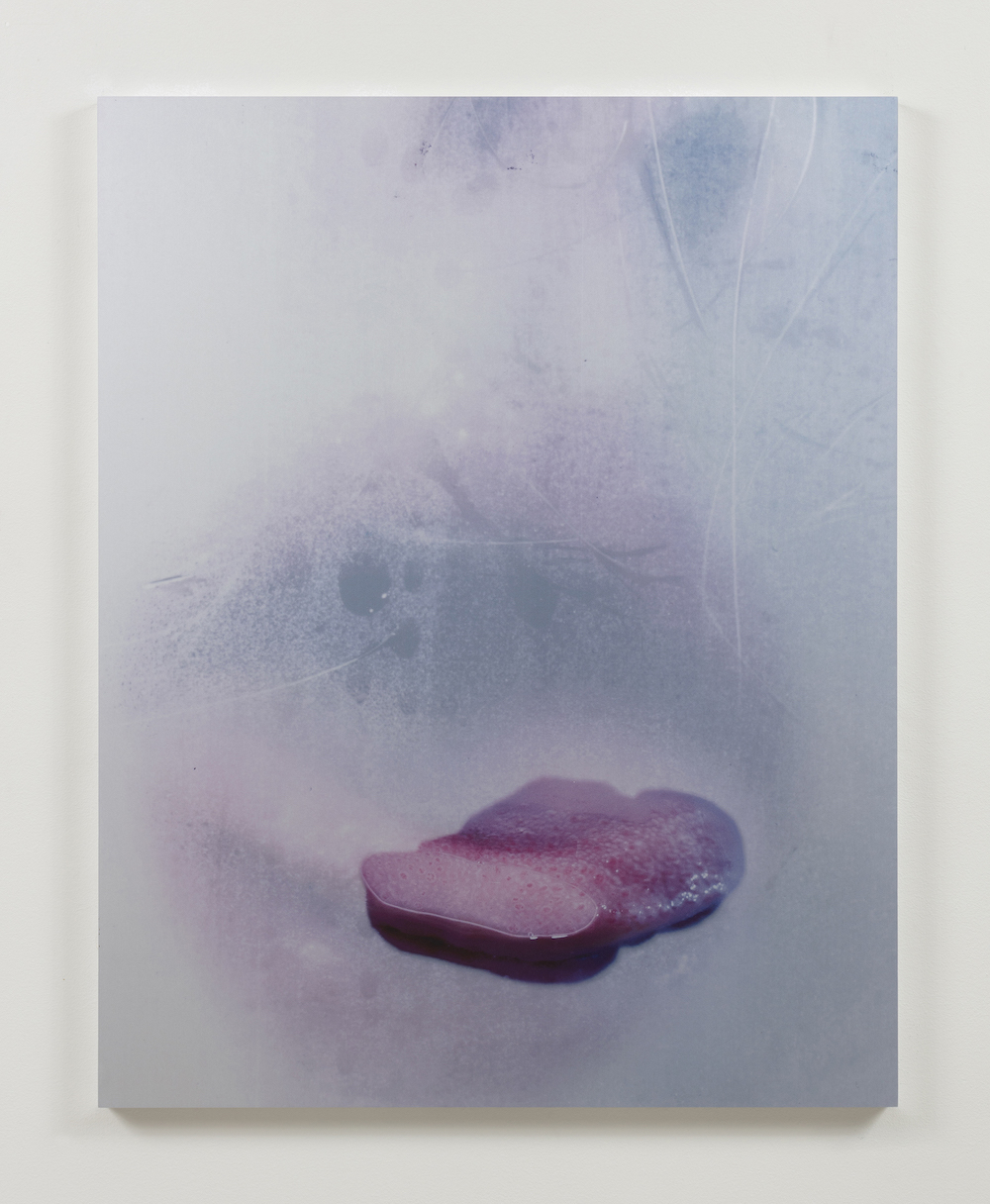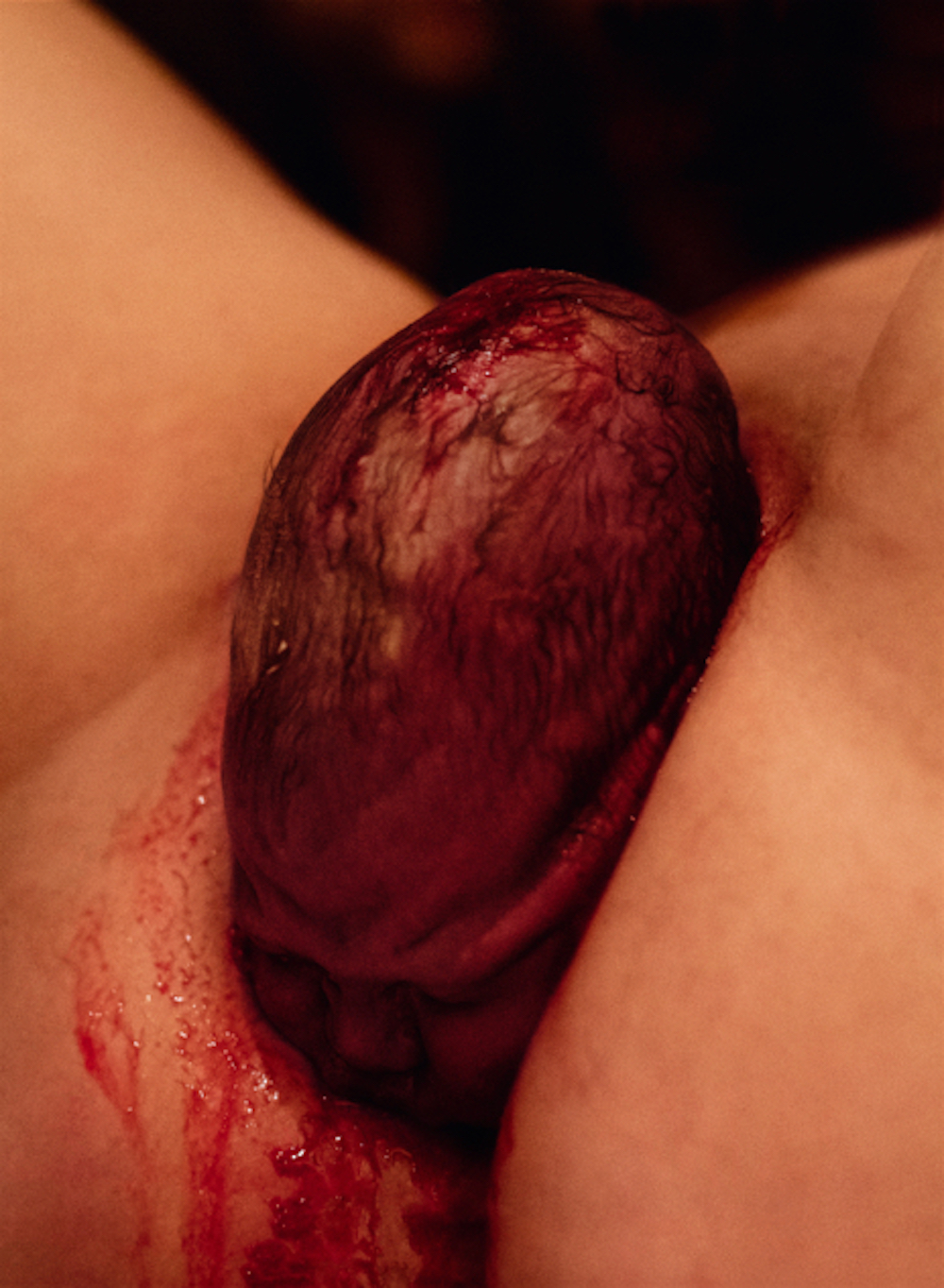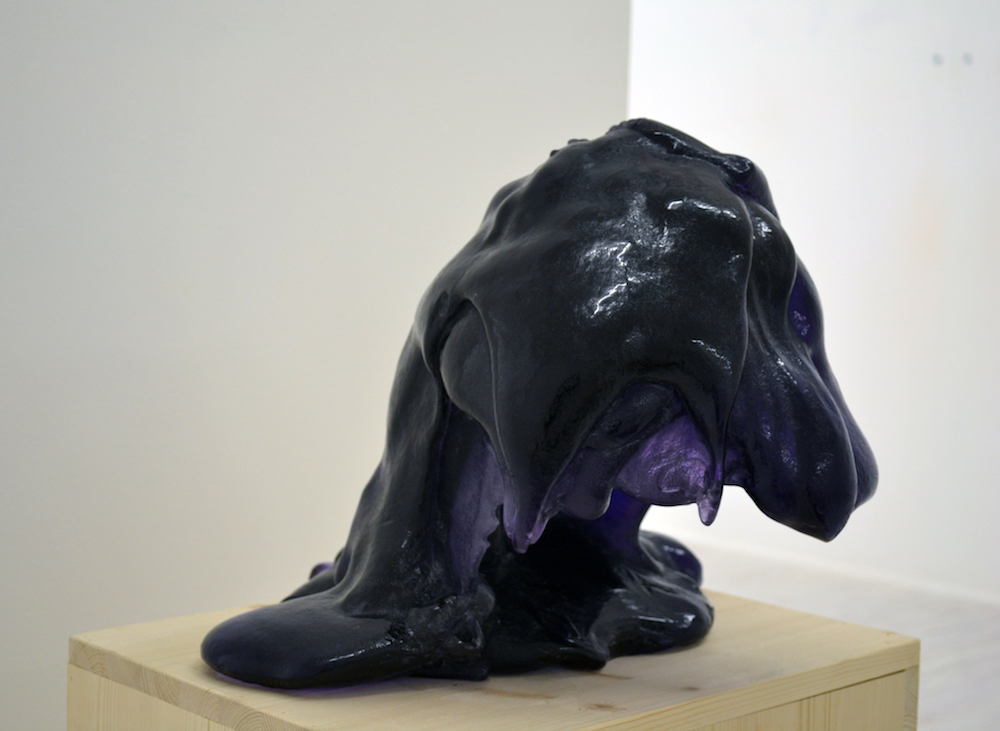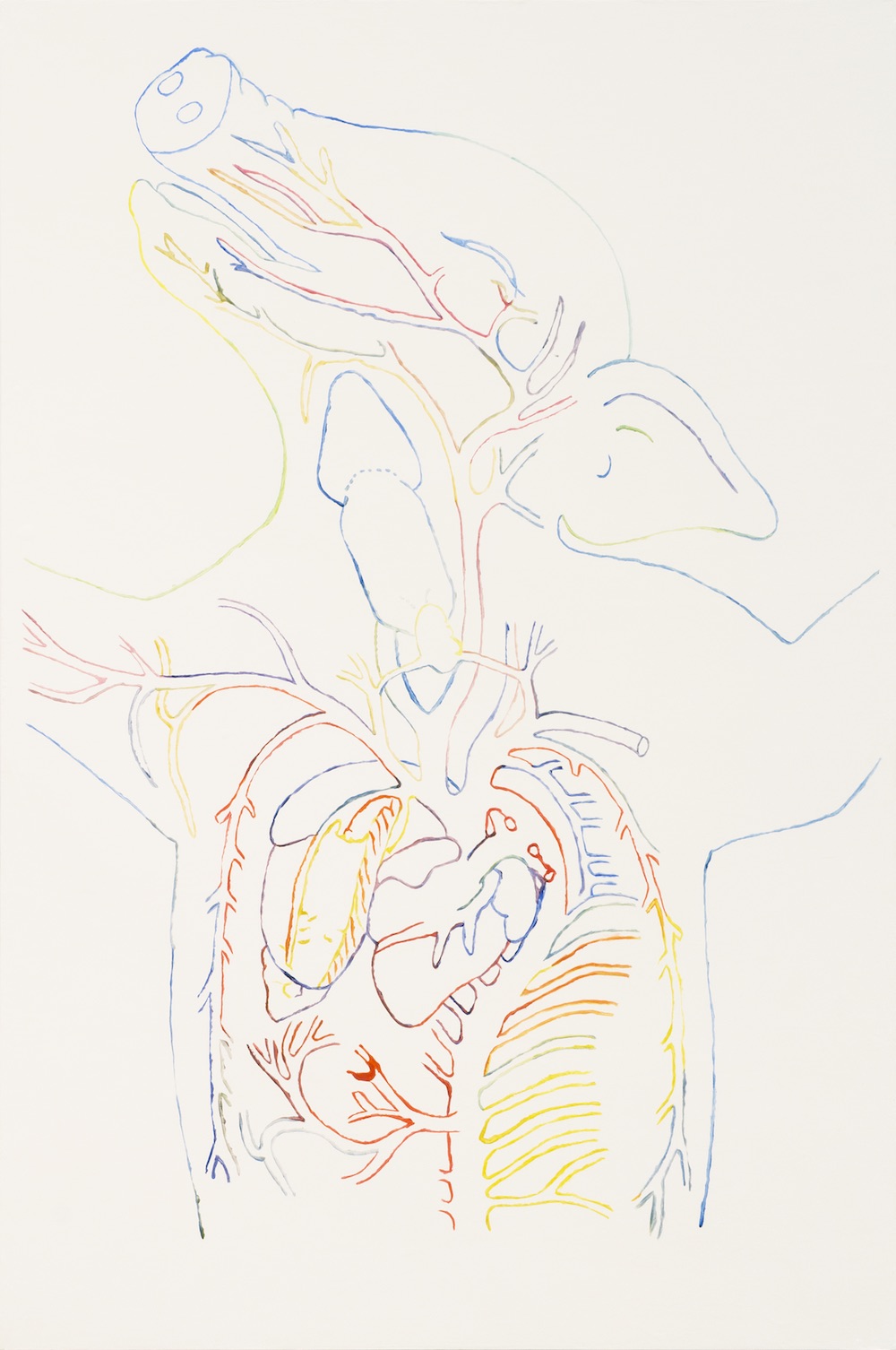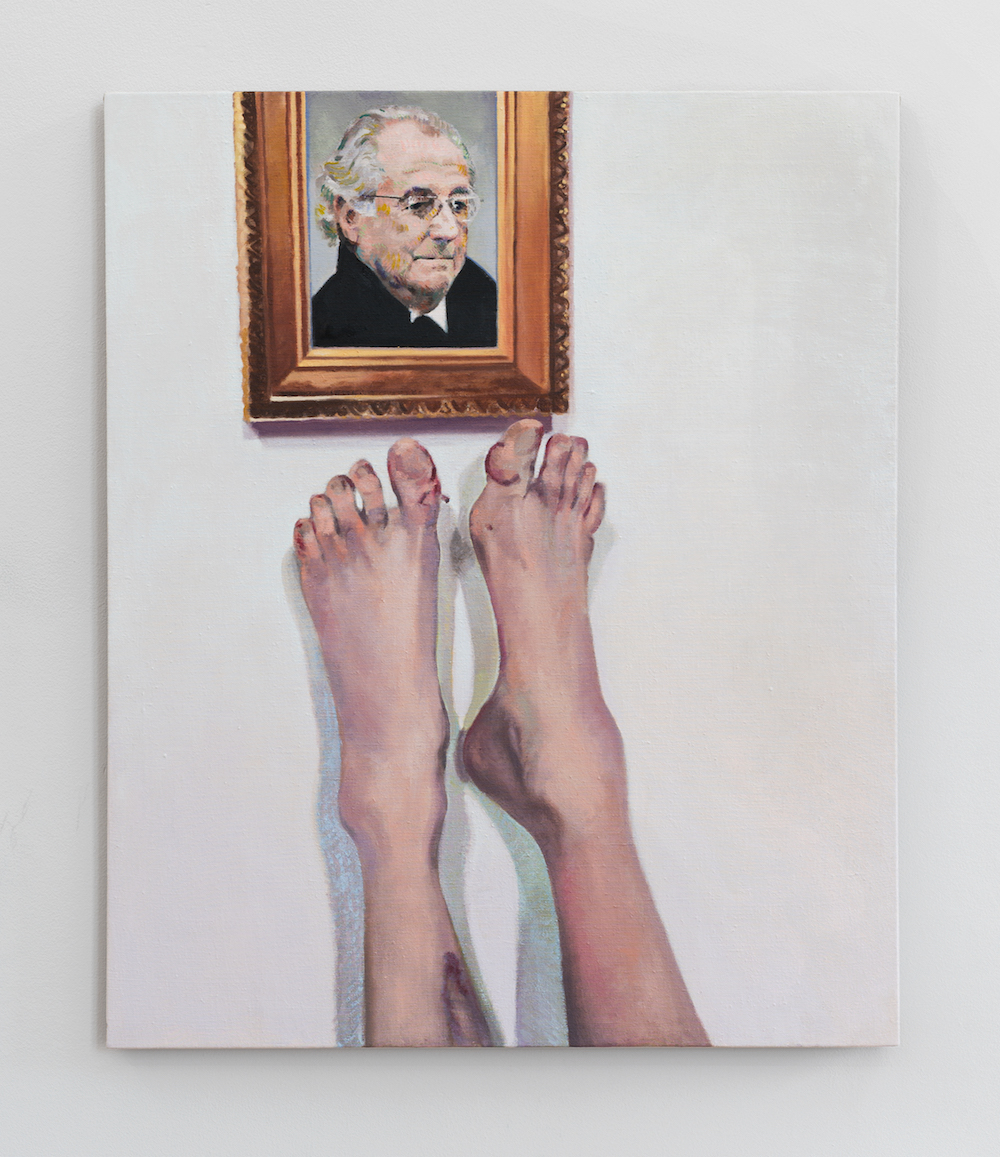
Nolan Simon, Getting Even, 2017 Oil on linen Courtesy the artist and Lars Friedrich, Berlin
It’s rare than an artwork actually makes you recoil. Gross artworks—sticky substances and graphic scenes—really confront our expectation that art should look pretty and play with the idea of taste (a bold move if this is what you’re showing at an art fair unless you know that you have some unusual collectors). As you ascend the stairs at Art Cologne—from the Modern masters to the younger galleries and independent presentations on the third floor—the greater the grossness.
Being gross isn’t always gratuitous. Art that can be disgusting is self-confident, unyielding and subversive. Here are the most wonderfully weird works we spotted at the fair. Not for the faint hearted—and probably NSFW, unless you happen to work at one of these galleries.
Heji Shin’s birth photos at Galerie Bernhard
“What the FUCK is that?!” I heard one passer-by exclaim, gesturing towards Hejin Shin’s large-format photo. It was a valid question. At a glance, the bloody, tumour-like substance emerging from between the legs is confounding. Only if you dare to go up close, will you see that it’s actually the most natural thing in the world: it’s not a tumour, it’s a baby being born. Its head is only just out—a moment deliberately chosen by Shin, who shot several babies being born in Germany in 2016 for this series. It’s bloody, gruesome, hard to take, but this is how we all began (without the camera in our barely-emerged face). Shin captures all the worst fears we might have as women—and men—about giving birth. The way she frames her pictures puts all of our focus on the very physical, painful act as it happens. It’s animalistic and it certainly isn’t pretty, but it’s not often you get to confront these kinds of scenes, and certainly not at an art fair.
Peter Szalay’s Jesus crucified on a steering wheel at acb Gallery
If Jesus were to be born again, perhaps he would be crucified on a steering wheel this time. “The piece is playing with a polysemic word kormány in the Hungarian language which refers to the steering wheel and the government as well. By using it as a crucifix, he is reflecting on the controversial and demagogic use of religion in current political movements and ideologies.” Says acb gallery, of Peter Szalay’s very unforgettable sculpture.
Lynda Benglis’ faecal goo at Thomas Brambilla
Lynda Benglis is the goddess of goo, her oozing sculptures evoke all kinds of bodily sensations, and this blackish, purplish, sci-fi rendition, the texture of sticky alien blood, is a perfect example. As always with Benglis, texture can convey so much more meaning than a figure: this lumpen sculpture is post-apocalypse meltdown distilled to a single form. Yes, it’s repugnant, but you also want to sink your hands into it (which wouldn’t work, of course, as it’s actually solid).
Marilyn Minter’s disembodied tongue at Carolina Nitsch
You know the feeling when your tongue gets stuck to a cold, frosted window or a lump of ice? This new work by the original feminist badass Marilyn Minter, part of series of five photographs, Spray On (2016), printed on aluminium panels, is just that. To shoot her subjects, Minter placed a steamy, semi-transparent glass panel between her model and the camera. The floating slab of tongue is disembodied, instantly recognisable for its texture. Only on stepping back does a face emerge in the image, and the tongue slides back into place. This perfect juxtaposition of the raw, fleshy weirdness of the actual physical body, and the archetypal sexy image of a woman with her tongue rolling provocatively out is particularly effective with the iridescent surface Minter has used.
Dale Lewis’ bad acid trip at Choi&Lager
Dale Lewis’ Cash Convertors is the most recent in a new series of paintings, presented by Korean gallery Choi&Lager. “The people depicted in the works are always painted from memory overlaid on a composition usually taken from renaissance masterpieces. In this case ‘cash converters’ references Pieta of Cannon Luis Despia by Bermejo Bartolome, 1490. The painting is based on a married couple that I saw in a shop (Cash Converters) on new years eve. The couple pawned their mobile phones for £20 each and used the proceeds to buy drugs. The bright red and yellow in the work draws attention to the colour of the branding on the cash converter stores which they have over two hundred of in the UK,” the artist explains. “The work brings attention to my familiar circulating subject matter such as; society breakdown, poverty, drug and alcohol addiction, illness, disease, death and violence.” The nightmarish chaos is like a bad LSD trip, warped figures and garish expressions, into which the markers of reality dissolve. “The cans of strong cider on the floor place the image in the street and further suggest addiction and dependency. The Adidas and Nike logos on clothes and shoes are a reoccurring motif in my paintings. I like the graphic quality of them. I like the fact they are cheap, casual and informal suggesting a certain type of person’s attitude to life.”
Nolan Simon’s bleeding feet at Lars Friedrich
I don’t have strong opinions on feet, but even those with a fetish might wince at this one. “The works on show in Cologne are painted under the influence of, as the artist said, reading Man with a Blue Scarf, Martin Gayford’s notes on having his portrait painted by Lucian Freud and looking intensively at the works of Pierre Bonnard.” Say Lars Friedrich gallery of Getting Even (2017), a painting by Nolan Simon, depicting a dancer’s mangled, bleeding feet. It’s hardly ‘hot dogs or legs’. Reclining under a portrait of Bernie Madoff, the painting considers the private act of painting, the relationship between muse, painter and painting, and how this encounter is shifted when it’s presented in public. “The bleeding feet are those of a dancer which implies a certain kind of hard physical work and a probably very direct intimate relationship with your body since it might always hurt (my idea of a dancer). Bernie’s work of destruction is a bit more abstract at least in the first place. But more central might be the idea of who you actually address when you look at a public figure.”
Olga Pedan’s dissected pig At Drei
“The dissected pig is actually related to the artist’s ongoing investigation of the the effects of an unleashed financial capitalism fired by the use of algorithms such as social bots,” says local gallery Drei of American artist Olga Pedan’s Gris (2017), an oil and chalk gesso on wood drawing. Having recently watched a film about medical dissection, the technical-looking drawing stood out to me. “The pig is a recurring motif within Olga Pedan’s work as pigs are very closely related to the human race with a surprisingly high intelligence and physical attributes such as their warm and friendly eyes with big eyelashes. The artist sees deep similarities between the way we treat pigs and the way we treat humans.” We’re familiar with all sorts of bits of the pig—especially after a few hotel breakfasts in Germany—but we don’t often look at the insides in this kind of detail. It’s part of a much wider concern with consuming and economy in the digital age, according to Drei. “The dream is to not have to work and to live off the residues of one’s own and others’ consumption. Residual Life Institute is one such scheme, promising you the prospect of generating passive income just by using and recruiting others to use their services. Ironically they promote their service by saying they will donate money to food banks for every transaction you make, adding a step below you on the ladder of residual dependency. In a world where consumption is the minimum requirement for being considered living, residual income schemes seem like a form of self-cannibalism. Perhaps there is a secret alchemical truth in this; a serpent eating its own tail.”
Today, 29 April, is the final day of Art Cologne. artcologne.com.
